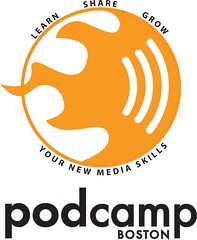As we wrap up 2008 and the interesting year that it was, I wanted to throw out some ideas there for PodCamp organizers for 2009.
 1. Use the tools! 2008 showed rapid growth in every social network of note, and as organizers, the more you can help people meet and greet prior to the event, the better. Set up Twitter accounts for your event, groups on Facebook, MySpace, LinkedIn, and many others, use search and readers and RSS to keep tabs on word of mouth. There’s no shortage of opportunities to help your participants connect in advance. At MarketingProfs’ Digital Marketing Mixer, every speaker’s Twitter handle was bundled on a handout – no reason that every participant at a PodCamp who’s active in social media can’t make a directory listing in the event’s wiki.
1. Use the tools! 2008 showed rapid growth in every social network of note, and as organizers, the more you can help people meet and greet prior to the event, the better. Set up Twitter accounts for your event, groups on Facebook, MySpace, LinkedIn, and many others, use search and readers and RSS to keep tabs on word of mouth. There’s no shortage of opportunities to help your participants connect in advance. At MarketingProfs’ Digital Marketing Mixer, every speaker’s Twitter handle was bundled on a handout – no reason that every participant at a PodCamp who’s active in social media can’t make a directory listing in the event’s wiki.
2. Separate lecture from conversation. Mitch Joel pointed this out in his Pixelated conference series, where he and others gathered together the talking head portions of major conferences. Figure out what makes your local PodCamp special and what’s just talking head stuff, and provide talking head stuff well in advance so that participants can maximize their time together. Grab videos of folks like Mitch, CC Chapman, Chris Brogan, and many other PodCamp favorites far ahead of the event and share them so that when participants arrive, they’re ready to collaborate and share, rather than passively listen.
3. Go paid. The economy has made life tough for the end user and consumer, but even tougher for the marketing budget. Plan your PodCamp to run 100% participant-paid at the door. If you get sponsors, great, but don’t bet the farm on them, and don’t financially extend your PodCamp beyond what money you already have in the bank. Continue to publish your ledgers publicly so participants can see how every dollar is allocated, but strongly consider going paid and having the event be wholly “sponsored” by the participants.
4. Support your local community. Pick a local charity and find a way to divert time, energy, or resources to it so that your community is a little better off for having a PodCamp.
5. Stay lightweight. Keep expenses to a minimum. We’re all adults for the most part who can locate the nearest Starbucks, Dunkin, or McDonald’s. The magic of PodCamp isn’t in refreshments or epic sponsored parties, but in bringing together people to learn, share, and grow their skills. Some facilities will allow you to unbundle catering from facility rental, which can keep costs way down, as food & drink are typically the most expensive part of any conference.
6. Add pieces along the way. Start with barebones expectations for attendees. As funding becomes available, you can add amenities later. Set expectations low, and you’ll never disappoint.
What things have you learned from PodCamps and other conferences in 2008 that you would pass on to PodCamp organizers for 2009? Leave your comments below!
Did you enjoy this blog post? If so, please subscribe right now!
Get this and other great articles from the source at www.ChristopherSPenn.com
10 most recent blog posts of mine:
Subscribe to RSS headline updates from:
Powered by FeedBurner



Leave a Reply